Written by Nicole Gunkel, RVT
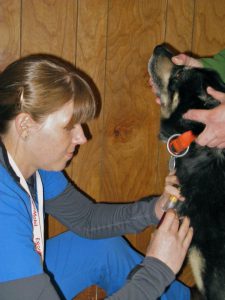 As a volunteer veterinary technician for the Iditarod Trail Sled Dog Race I primarily help with the ECG and Bloodwork program. In order to be eligible to race all sled dogs have blood drawn and checked for internal health of the dog and electrocardiograms (ECG for short) run to determine healthy rhythm and heart activity. This year I learned a little more the electrocardiograms (ECG for short) that we run on the sled dogs.
As a volunteer veterinary technician for the Iditarod Trail Sled Dog Race I primarily help with the ECG and Bloodwork program. In order to be eligible to race all sled dogs have blood drawn and checked for internal health of the dog and electrocardiograms (ECG for short) run to determine healthy rhythm and heart activity. This year I learned a little more the electrocardiograms (ECG for short) that we run on the sled dogs.
When dog teams come for their appointment to have their blood drawn and ECG’s read the first thing we do is scan to make sure the dog has a microchip. This is used for identification and the number is linked will all testing that is done for the life of the animal. Blood is drawn using a singlestick vacutainer method by a Registered (certified or licensed) Veterinary Technician, like myself. The blood is sent to the Providence Hospital in Anchorage for testing. Next the dog is brought to our ECG station.
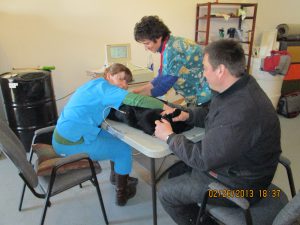 Since lying down on a table can be a little scary for a sled dog, the musher lifts the dog onto the table. We are trained to carefully and slowly roll the dog onto their side so that they are laying, right side down, on the table. The musher is instructed to sit at the dog’s head. Here they can pet their head and ears and talk to them calmly and reassure the dog’s that they are ok. It is important that the dog be as calm and still as possible for a good, clear reading. We only need a minimum of 8-seconds of the dog lying as calmly as possible. Since sled dogs have thick fur coats, instead of sticking the cables to the skin as in people, cables are attached to the dogs with small clamps. The machine we use for the Iditarod has 6 cables that are attached to specific points on the body. These leads measure the electrical activity in the heart and give us the tracing we know as an ECG.
Since lying down on a table can be a little scary for a sled dog, the musher lifts the dog onto the table. We are trained to carefully and slowly roll the dog onto their side so that they are laying, right side down, on the table. The musher is instructed to sit at the dog’s head. Here they can pet their head and ears and talk to them calmly and reassure the dog’s that they are ok. It is important that the dog be as calm and still as possible for a good, clear reading. We only need a minimum of 8-seconds of the dog lying as calmly as possible. Since sled dogs have thick fur coats, instead of sticking the cables to the skin as in people, cables are attached to the dogs with small clamps. The machine we use for the Iditarod has 6 cables that are attached to specific points on the body. These leads measure the electrical activity in the heart and give us the tracing we know as an ECG.
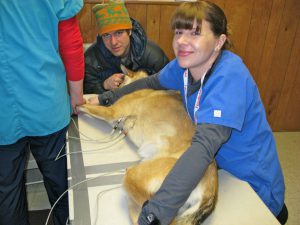 Recording ECG’s on Iditarod sled dogs has been done since 1992. The ECG’s are recorded and saved on disk as well as printed out on paper. Dr. Peter Constable from Purdue University of Veterinary Medicine reads all electrocardiograms. He has been working with the Iditarod Trail Sled Dog Race for many years now and collects the ECG readings as a part of a continual study on the hearts of sled dogs. Usually 1-2 dogs end up not being allowed to race based on the results of their reading. In 2013, all dogs tested were deemed suitable to race based on their ECG!
Recording ECG’s on Iditarod sled dogs has been done since 1992. The ECG’s are recorded and saved on disk as well as printed out on paper. Dr. Peter Constable from Purdue University of Veterinary Medicine reads all electrocardiograms. He has been working with the Iditarod Trail Sled Dog Race for many years now and collects the ECG readings as a part of a continual study on the hearts of sled dogs. Usually 1-2 dogs end up not being allowed to race based on the results of their reading. In 2013, all dogs tested were deemed suitable to race based on their ECG!
Due to the large amount of training and conditioning it is not uncommon to see irregularities that in sled dogs indicates large athletic hearts, where in a human would be an indicator of heart disease. Some of these irregularities would also be a concern in our average housedog, where as we consider them 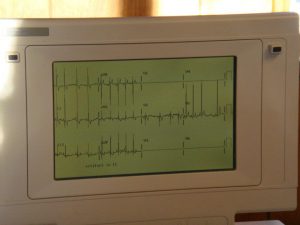 normal in a athletic sled dog. Since 2008, the number of athletic hearts in Iditarod sled dogs has increased from 1% to about 2%. During this same time there has also been an increase in arrhythmia’s seen in these same dogs from 1 to 2.2%. Dr. Constable sees more abnormalities in teams that are better conditioned and more competitive. When comparing sled dogs to human athletes, Dr. Constable said they compare most closely to an Olympic rower.
normal in a athletic sled dog. Since 2008, the number of athletic hearts in Iditarod sled dogs has increased from 1% to about 2%. During this same time there has also been an increase in arrhythmia’s seen in these same dogs from 1 to 2.2%. Dr. Constable sees more abnormalities in teams that are better conditioned and more competitive. When comparing sled dogs to human athletes, Dr. Constable said they compare most closely to an Olympic rower.
This year we recorded electrocardiograms on 1,334 sled dogs! It was such a great experience this year to meet Dr. Constable and learn from him as he pointed out the arrhythmias! Learning from him will help me to be better at my job both in practice at Animal Care Clinic and as a volunteer veterinary technician for the Iditarod! To learn more about the Iditarod check out the Iditarod website! Read more about the testing I help with in an article written this year when we were visited by one of the Iditarod bloggers!

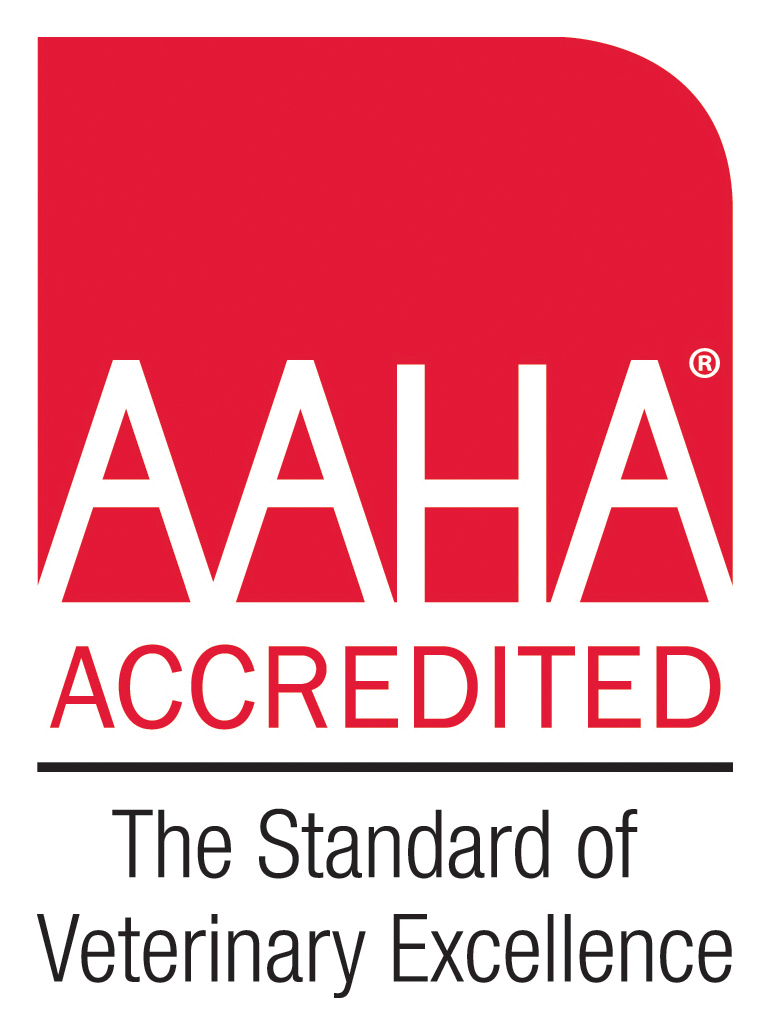







Leave A Comment
You must be logged in to post a comment.